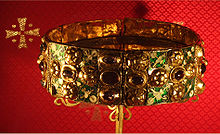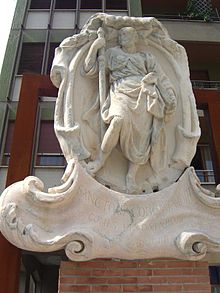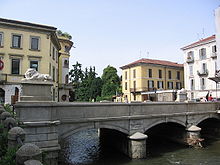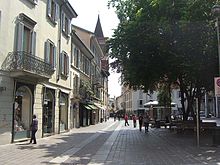- Monza
-
Monza — Comune — Comune di Monza A collage showing different features of the city of Monza. 
Coat of armsLocation of Monza in Italy Coordinates: 45°35′N 9°16′E / 45.583°N 9.267°ECoordinates: 45°35′N 9°16′E / 45.583°N 9.267°E Country Italy Region Lombardy Province Monza and Brianza (MB) Government - Mayor Marco Maria Mariani Area - Total 33.03 km2 (12.8 sq mi) Elevation 162 m (531 ft) Population (30 April 2009) - Total 121,466 - Density 3,677.4/km2 (9,524.5/sq mi) Demonym Monzesi Time zone CET (UTC+1) - Summer (DST) CEST (UTC+2) Postal code 20900 Dialing code 039 Patron saint St. John the Baptist, St. Gerard of Dyers Saint day June 24, June 6 Website Official website Monza
 listen (help·info) is a city and comune on the river Lambro, a tributary of the Po, in the Lombardy region of Italy some 15 km north-northeast of Milan. It is the capital of the Province of Monza and Brianza. It is best known for its Grand Prix motor racing circuit, the Autodromo Nazionale Monza.
listen (help·info) is a city and comune on the river Lambro, a tributary of the Po, in the Lombardy region of Italy some 15 km north-northeast of Milan. It is the capital of the Province of Monza and Brianza. It is best known for its Grand Prix motor racing circuit, the Autodromo Nazionale Monza.On June 11, 2004 Monza was designated the capital of the new province of Monza and Brianza. The new administrative arrangement came fully into effect in summer 2009; previously, Monza was a comune within the province of Milan.
Monza is the third-largest city of Lombardy and the most important economic, industrial and administrative centre of the Brianza area, supporting a textile industry and a publishing trade.
Monza also hosts a Department of the University of Milan Bicocca, a Court of Justice and several offices of regional administration. Monza Park is one of the largest urban parks in Europe.
Contents
Geography and topography
Monza is located in the high plains of Lombardy, between the Brianza and Milan, at an altitude of 162 meters above sea level is 15 kilometres (9 mi) from the capital of the region and about 40 km (25 mi) from Lecco and Como. Its territory is crossed from north to south by the river Lambro. At the entrance to the north in the center, between the streets Via Aliprandi and Via Zanzi, a fork of the river artificially created for defensive purposes in the early decades of the fourteenth century gives rise to Lambretto, which is joined to the main course Lambro at its exit to the south from the ancient circle of medieval walls (Monza) (now completely demolished). Another stream, which is also artificial, is the Canale Villoresi, released in nineteenth century.
Quality of life
Climate
Monza has the typical submediterranean climate of the Po valley, with cool, short winters and warm summers; temperatures are very similar to Milan and vary from about 2 °C (36 °F) in January, the coldest month, to about 23 °C (73 °F) in July, the warmest.[1] Precipitation is abundant, with a slight maximum in fall and a slight minimum in winter and summer; despite this, normally, the area of the city doesn't suffer drought in any season.
Monza Park
Monza Park and the gardens of the Royal Palace are of notable interest. This Park is one of the major historic parks in Europe, and the higher ones enclosed by walls. It has an area of approximately 685 hectares and is located in the northern part of the city, between the towns of Lesmo, Villasanta, Vedano al Lambro and Biassono. With the gardens of Villa Reale in Monza Park constitutes an invaluable natural, historical, and architectural monuments.
Royal Villa
The Royal Villa is one of the most important monuments of the city. The villa was built during the period of Austrian rule in the Duchy of Milan, as a symbol of luxury and magnificence of the Habsburg court, commissioned by the Empress Maria Theresa of Austria and dedicated to her fourth son, the Archduke Ferdinand of Austria, who at that time resided in Milan, as governor of Lombardy and he wanted a Villa outside the city to spend the summer season and for hunting. Work began in 1777 under the guidance of Giuseppe Piermarini and it consists of a central body and two wings that branch off at right angles. From the gardens of the Royal Villa it is possible to access Monza Park.
History
Origins in the Bronze Age
Late nineteenth-century finds of funerary urns show that the human presence in the area dates back at least to the Bronze Age, when people would have lived in settlements of pile dwellings raised above the rivers and marshes.
The Roman period
During the third century BCE the Romans subdued the Insubres, Gauls who had crossed the Alps and settled around Mediolanum (now Milan). A gallo-celtic tribe, who also seem to have been Insubres, then founded a village on the Lambro, of which the ruins of a bridge remain. Standing in a place where young people practised sports, the bridge was named ‘Arena’ and its remains can be seen near today’s Ponte dei Leoni (Lions Bridge).
During the Roman Empire the town was known as Modicia.
The Lombards
The Lombard invasion of Italy was an important event in Monza's history and the Lombard king Autari married Theodelinda, daughter of the Bavarian ruler Garibald I.
The new queen ordered the construction near the River Lambro of an oraculum, a sort of little church, that today is part of the basilica of Saint John. Paul the Deacon, an 8th century historian of the Lombards, tells us about this, writing: "[...] Theudelinda regina basilicam costruxerat, qui locus supra Mediolanum duodecim milibus abest, [...]" ("Theodelinda built a queen basilica, whose position is twelve miles from Milan"). There is also an important legend that Theodelinda, asleep while her husband was hunting, saw in a dream a dove who told her : "Modo", Latin for "here", in order to say that she should build the oraculum in that place, and the queen answered "etiam", meaning "yes". So from the two words "modo" and "etiam", following the legend, would have derived "Modoetia", the medieval name of Monza.
Middle Ages
In the Middle Ages, the commune of Monza was sometimes independent, sometimes subject to Milan and the Visconti.
XIX century
The first rail road built in North Italy was the Milan and Monza Rail Road opened for service on August 17, 1840.
XX century
On the evening of 29 July 1900 King Umberto I of Italy was assassinated in Monza by the anarchist Gaetano Bresci.
The Simble
The medieval coat of arms
The oldest coat of arms used by the town of Monza is a celestial shield,which depicts a crescent moon red with a white semi-circle to the chin. The coat of arms, goes back to thirteenth century. If it finds a representation in miniature of the cover placed on the Code of Statutes of the City is still preserved in the Chapter Library of the Duomo of Monza. According to the interpretation of the historic Bonincontri Morigia, which refers to the medieval symbolism, the moon is a symbol of imperial power, reflected in the white sun that is related to the papal power.
The actual coat of arms
The coat of arms bearing the motto and the iron crown was originally granted a seal, according to the Morigia, by Otto III, at the time of his coronation in 996 at Monza. It was later recognized by decree of May 6, 1835 Emperor of Austria Ferdinand I of Austria was confirmed in almost identical form by a decree of 1933. In 2003 it was redesigned so that it was a version used uniformly by all municipal offices.
Main sights
In the course of its history Monza withstood thirty-two sieges, but the Porta d'Agrate is all that remains of its original walls and fortifications. Nearby is the nunnery in which the nun of Monza was enclosed in Manzoni's I Promessi Sposi.
Monza is famous for its Romanesque-Gothic Duomo of Saint John. There Theodelinda's centrally-planned Greek-cross oraculum ("chapel of prayer") from c. 595 (its foundations remaining under the crossing of nave and transept) was enlarged at the close of the 13th century by enclosing the former atrium within the building. The fine black and-white marble arcaded façade was erected in the mid-14th century by Matteo da Campione. The campanile was erected in 1606 to designs by Pellegrino Tibaldi. In the frescoed Chapel of Theodelinda is the Iron Crown of Lombardy, supposed to contain one of the nails used at the Crucifixion. The treasury also contains the crown, fan and gold comb of Theodelinda, and, as well as Gothic crosses and reliquaries, a golden hen and seven chickens, representing Lombardy and her seven provinces. Though the interior has suffered changes, there is a fine relief by Matteo da Campione representing a royal Lombard coronation, and some 15th-century frescoes with scenes from the life of Theodelinda.
The historical centre also include:
- the church of Santa Maria in Strada, with a rich terra-cotta façade of 1393
- the Broletto or Arengario, the 14th-century palace of the civic commune, raised on an arcade of pointed arches, with a tall square machiolated tower terminating in a sharp central cone.
- the church of San Pietro Martire
- the memorial Cappella Espiatoria, built in 1900 in memory of the assassinated King Umberto I of Italy
- Church of Santa Maria delle Grazie (15ht century)
- Oratory of St. Gregory (17th century)
- church of Santa Maria al Carrobiolo (16th century)
Nearby, the Villa Reale (royal palace) originally built by Giuseppe Piermarini in 1777 for the archduke Ferdinand of Austria, lies on the banks of the Lambro, surrounded by Monza Park, one of the largest enclosed parks in Europe.
Other villas includes the Mirabello, Mirabellino, Durini, Crivelli Mesmer, Prata, Archinto Pennati, Calloni and Villa Carminati-Ferrario.
Culture and education
Libraries
There are at least seven libraries:
- Civica Library, Padre Reginaldo Giuliani 1/a, road
- Library of boys, Trento e Trieste 6 square
- Saint Gerard Library, Lecco 12 road
- Cederna Library, Zuccoli 16 road
- Triante Library, Monte Amiata 60 road
- S. Rocco Library, Zara 9 road
- Park of Monza Library, Villa Mirabello
University
In Monza are located two detachments of the University of Milan Bicocca: the faculty of Medicine and Surgery and the Faculty of Sociology.
Museums
The Duomo's (Cathedral) Museum collection keep treasures from the time of Queen Theodolinda, including the Hen with chicks, the Cross of Agilulf, and the famous Iron Crown.
Theatres and cinemas
Are: Teatro Manzoni (Manzoni Theatre); Teatro Villoresi (Villoresi Theatre); Teatro Binario 7 (Binario 7 Theatre), Sala San Carlo; AreaOdeon; Cinema Capitol; Cinema Metropol; Cinema Teodolinda
Economy
Tourism and Events
- F1 grand Prix, at the beginning of September
- Feast of St. Gerard, on 6 June
Sport
Monza is internationally known for the Autodromo Nazionale Monza motor racing circuit, home to the Italian Grand Prix, and previously to the Alfa Romeo team. The circuit is inside the "Parco di Monza", a park that is double the size of New York's Central Park.
Monza is also known for the "Villa Reale", a Habsburg family residence built in 1777.
The professional football club A.C. Monza Brianza 1912 play, currently in Serie C1, at the Stadio Brianteo.
The professional volleyball club Acqua Paradiso Gabeca Monza Brianza play, currently in Serie A1, at the PalaIper.
In 2006 Monza hosted the World Cyber Games tournament.
In July 2005 and July 2008, Monza hosted the "International Gran Galà Marching Show Bands" at Stadio Brianteo (with the USA band Blue Devils, 11 times WMSB Champion of the World).[citation needed]
Transport
Rail
Monza railway station is the most important railway junction in the Brianza area. Every few minutes, trains travel between Monza and Milano via the Suburban Railway (Line S9) and via local trains that connect Monza to Lecco, Como/Chiasso (CH) and Bergamo/Brescia. Also some EuroCity trains stop in Monza. In early 2008, work began on the expansion of Subway Line MM1 from Milano/Sesto San Giovanni to Monza Bettola. Monza railway station is located in Enrico Arosio Road.
Roads
Monza can be reached through the following motorways: A4-E64 (Turin-Milan-Venice), A52 (North Ring of Milan), A51 (East Ring of Milan). State road (SS.36 - Nuova Valassina) connect the city to Lecco and Sondrio. A 2 km long tunnel will be added by around September 2011 and will alleviate traffic problems that are happening in the city. The center is off limits to cars and other motorized vehicles.
Notable People
- Theodelinda, (c.570-628) Queen of Lombardy
- St. Gerard of Dyers, (c. 1134 or 1140–1207), Saint
- Carlo Amati (1776–1852), architect
- Paolo Mantegazza (1831–1910), neurologist, physiologist and anthropologist
- Emilio Borsa (1857–1931), painter
- Gerolamo Gaslini (1877–1964), olear industrialist and philanthropists
- Vittorio Brambilla (1937–2001), F1 racer
- Daniele Massaro (1961), footballer
- Marco Monti (1964) Italian former footballer and youth coach
- Pierluigi Casiraghi (1969) Italian former footballer
- Stefano Mauri, (1980) fottballer
Gallery of Notable People
-
Theodelinda, Queen of Lombardy
-
Paolo Mantegazza, neurologist, physiologist and anthropologist
-
Gianni Bugno, ciclyst
-
Stefano Mauri, footballer
Demography
This city is the third place of Lombardy for number of population, with 122.712 citizens (58.744 males; 63.968 females). In Monza, the regular immigrants are 11.642, with 121 different nationalities.
Immigration
[1] - Demografic Stats
Twin cities

 Indianapolis, United States
Indianapolis, United States Praha, Czech Republic
Praha, Czech Republic
References
Bibliography
- AA.VV. Biographyc Dizionary of Italians. Rome, 1960 (Aliprandi Pinalla).
- AA.VV. Church of St. Mark in Milan. Milan, 1998. Pag. 56-57 (Aliprandi Martino).
- Il Duomo di Monza, 1300-2000, VII Centenary of foundation. Silvana Ed., 1999.
Gallery
-
Statue of King Vittorio Emanuele II
External links
- City of Monza
- Monza Transportation
- Province of Monza and Brianza
- Official website of the University of Milano-Bicocca
- Official website of Saint Gerard Hospital, nationally relevant with very high specialization
Lombardy · Comuni of the Province of Monza and Brianza Agrate Brianza · Aicurzio · Albiate · Arcore · Barlassina · Bellusco · Bernareggio · Besana in Brianza · Biassono · Bovisio-Masciago · Briosco · Brugherio · Burago di Molgora · Busnago · Camparada · Caponago · Carate Brianza · Carnate · Cavenago di Brianza · Ceriano Laghetto · Cesano Maderno · Cogliate · Concorezzo · Cornate d'Adda · Correzzana · Desio · Giussano · Lazzate · Lentate sul Seveso · Lesmo · Limbiate · Lissone · Macherio · Meda · Mezzago · Misinto · Monza · Muggiò · Nova Milanese · Ornago · Renate · Roncello · Ronco Briantino · Seregno · Seveso · Sovico · Sulbiate · Triuggio · Usmate Velate · Varedo · Vedano al Lambro · Veduggio con Colzano · Verano Brianza · Villasanta · VimercateCategories:- Cities and towns in Lombardy
- Communes of the Province of Monza and Brianza
- Monza
Wikimedia Foundation. 2010.



































